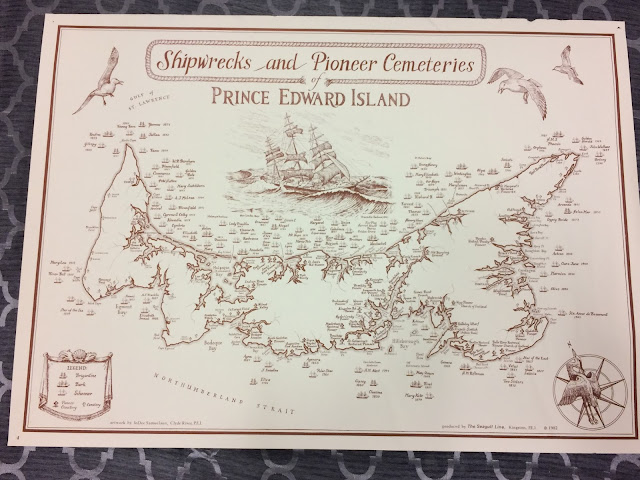PEI's First Major Fossil Find
When I was living in Toronto, I went to the Royal Ontario Museum and they were planning their next gallery, the Dawn of Life Gallery. One of the artefacts they included in their small gallery preview was from PEI. Like many people, I do not usually associate PEI with old fossils and dinosaurs. But when I started to look into the topic, I was impressed!
Originally, I was going to look at one or two examples, but one of our earliest finds is pretty interesting so I am going to focus on that one.
In 1854, Joseph Leidy found and named the Bathygnathus Borealis in French River, PEI. Originally, this was believed to be Canada's first dinosaur fossil and was described as the lower jaw bone of a meat-eating dinosaur from the Triassic Period. But in 1905, two paleontologists specializing in Permian fossils, F. von Huene and E.C. Case, realized this fossil was actually the upper jaw bone of an early synapsid.
What does this mean?
Well, the surviving synapsids are mammals. AKA Humans (and many, many others). But also the Permian Period came before the Triassic Period. To put it into an easy perspective:
This fossil came from the Permian Period, the T-Rex is from the late Cretaceous Period. . .
The difference is millions of years.
In 2015, scientists found out the Bathygnathus Borealis was actually a Dimetrodon, whose fossils have also been found in the United States and Germany. But this led to a debate over its name. Usually, the discoverer gets to name the find. If fossils that came from the same dinosaur, synapsid, animal, etc. is found later, it is referred to by the name given to it by the species' original finder.
But, the Bathygnathus Borealis and the Dimetrodon are the same species but found, and therefore named, decades apart...so which name do you use?
In this case, Dimetrodon won as the name was more well-known.
Rocks from the Permian Period can still be found along some of our coastlines - just be careful of the tides!
Sources:
Brink, Kirstin and Jessica Hawthorn. "ROM Research: Permian Tracks on P.E.I." Royal Ontario Museum. November 12, 2012. https://www.rom.on.ca/en/blog/rom-research-permian-trackways-pei
Chung, Emily. "Canada's 1st dimetrodon solves P.E.I. fossil mystery." CBC News: Technology and Science. November 25, 2015. http://www.cbc.ca/news/technology/pei-dimetrodon-1.3337072
MacLean, Jason. "PEI's celebrated dinosaur is actually a mammal." Cantech Letter. November 27, 2015. https://www.cantechletter.com/2015/11/peis-celebrated-dinosaur-is-actually-a-mammal-says-researchers/
Natural History Museum. "Dino Timeline." http://www.nhm.ac.uk/discover/dino-directory/timeline/late-triassic/gallery.html
Originally, I was going to look at one or two examples, but one of our earliest finds is pretty interesting so I am going to focus on that one.
In 1854, Joseph Leidy found and named the Bathygnathus Borealis in French River, PEI. Originally, this was believed to be Canada's first dinosaur fossil and was described as the lower jaw bone of a meat-eating dinosaur from the Triassic Period. But in 1905, two paleontologists specializing in Permian fossils, F. von Huene and E.C. Case, realized this fossil was actually the upper jaw bone of an early synapsid.
 |
| Image of the Bathygnathus Borealis fossil found by Joseph Leidy in French River in 1854. Image from CBC. |
What does this mean?
Well, the surviving synapsids are mammals. AKA Humans (and many, many others). But also the Permian Period came before the Triassic Period. To put it into an easy perspective:
This fossil came from the Permian Period, the T-Rex is from the late Cretaceous Period. . .
 |
| Found on giphy.com |
The difference is millions of years.
In 2015, scientists found out the Bathygnathus Borealis was actually a Dimetrodon, whose fossils have also been found in the United States and Germany. But this led to a debate over its name. Usually, the discoverer gets to name the find. If fossils that came from the same dinosaur, synapsid, animal, etc. is found later, it is referred to by the name given to it by the species' original finder.
But, the Bathygnathus Borealis and the Dimetrodon are the same species but found, and therefore named, decades apart...so which name do you use?
In this case, Dimetrodon won as the name was more well-known.
 |
| The Bathygnathus Borealis, or as it is now known, the Dimetrodon. Image from Cantech Letter. |
Rocks from the Permian Period can still be found along some of our coastlines - just be careful of the tides!
Sources:
Brink, Kirstin and Jessica Hawthorn. "ROM Research: Permian Tracks on P.E.I." Royal Ontario Museum. November 12, 2012. https://www.rom.on.ca/en/blog/rom-research-permian-trackways-pei
Chung, Emily. "Canada's 1st dimetrodon solves P.E.I. fossil mystery." CBC News: Technology and Science. November 25, 2015. http://www.cbc.ca/news/technology/pei-dimetrodon-1.3337072
MacLean, Jason. "PEI's celebrated dinosaur is actually a mammal." Cantech Letter. November 27, 2015. https://www.cantechletter.com/2015/11/peis-celebrated-dinosaur-is-actually-a-mammal-says-researchers/
Natural History Museum. "Dino Timeline." http://www.nhm.ac.uk/discover/dino-directory/timeline/late-triassic/gallery.html



Comments
Post a Comment